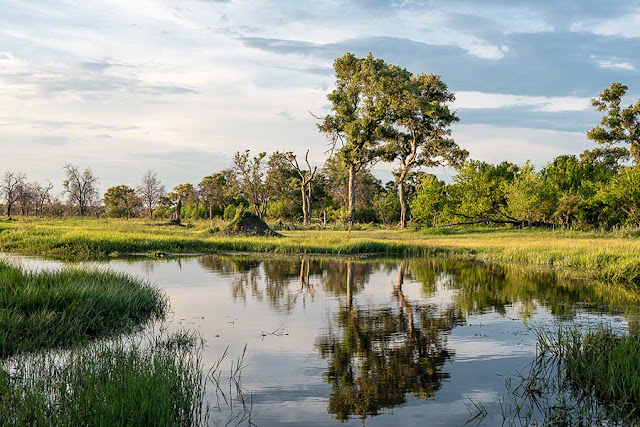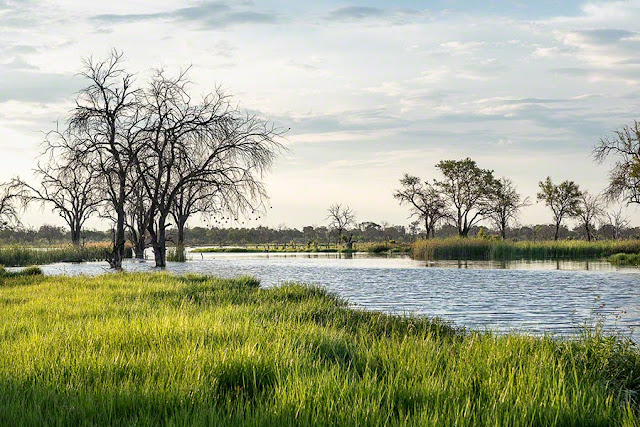The Khwai Community owns and manages a huge parcel of land between Moremi and Chobe National Parks. It is really just across the river from Moremi, but it took seven hours by road to arrive at the Khwai Community Campsite.
On the drive, we had some rain, but when the rain stopped we had a much more comfortable day with less humidity. We saw a large water monitor lizard and one of the many animals of my nightmares--a huge crocodile. This 12-feet long croc was sunning him/herself under a tree next to the river. It had its mouth open to expel heat from his/her body.
In the late afternoon, we saw a young elephant (dark gray from recently taking a bath) that kept annoying other herd members. He went from one to another pestering each one to fight or play with him. Eventually, the matriarch stepped in and gave him a shove. He squealed like a spoiled child and ran away to pout at a some distance from the herd.
Our camp is once again very secluded with a large grassy expanse behind the tents. Because this is a privately held concession, we can do night drives with spotlights to locate nocturnal animals. With the aid of the spotlight, we saw a Serval (the largest of the African Wildcats), a huge python, a giant eagle owl, a Spring Hare (a rodent that looks like a small kangaroo), and an African Wildcat which looked very much like a domestic cat with rings on its tail.
Our first night at the Khwai campsite just as we were getting into bed, we heard a small stampede behind the tent because a male lion was chasing a hyena. The hyena escaped and the lion sat in the middle of the grassy field behind our tents and roared his displeasure for about two hours. Eventually, he was joined by another male lion and they both sauntered away. If that wasn't enough to ruin my sleep, a few hours later I was awakened by repeated shrieking that I couldn't identify. Turns out it was hyenas shrieking around our campsite cooking area. That event was followed by elephants grazing around our tent. I was the only one who had a sleepless night.
The hyena-lion event was the second in a series of recent lion-hyena encounters. The day we arrived in Khwai, a group of hyenas had neutralized a male lion that had been skulking around their den area. The hyenas had had enough of the lion bothering them, and as a group, they attacked and killed him. Last night's lion-hyena incident was the lions' unsuccessful attempt at revenge. A couple of days later we happened across the dead lion still laying next to the hyena den complex. The lion's corpse was still intact. Even the vultures had not begun to feed on him. It was as if the hyenas had left the lion there as a warning like a trophy head on a pole.
In the daytime while searching for large predators we were lucky enough to spot several Steenbok. Steenboks are about 20 inches/50cm tall and 24 pounds/11kg at maturity. They look like they were created by Disney with beautiful, long eyelashes, large eyes, a cute nose. Steenboks are monogamous. To escape from predators, they can disguise themselves by curling their bodies into a rounded rock shape. In this rock disguise, one ear will wave back and forth mimicking a leaf. To avoid a chasing predator, it will jump into a small hole to escape. Like a cat, Steenboks cover their excrement to hide their presence.
One afternoon, we sat and watched a huge group of female impalas running, running, running in circles. At the height of their leap, they do a dive-like move with their little white tails held high like flags as they return to the ground. This move is called "stouting," and they look like they are doing it for the joy of moving.
Each day we have been searching for predators: wild dogs, leopards, lions. We hear their calls at night, but haven't had much luck during the day searches until Moses spotted two female lions lying under a bush in the shade. They were so camouflaged, it is amazing that he was able to spot them. They were more interested in napping so about 4pm we returned to the area to look again for them.
We did find them. First we saw one female walking across our path. She was muddy and had some blood around her mouth. Then, we found the other female happily feeding upon a freshly killed male warthog. Moses said the two lionesses had probably captured the warthog in a nearby pool of water and held it under to drown it. We watched the second lioness languorously remove and consume the intestines and other internal organs. She concentrated on her dinner and ignored our presence. We were less of a bother to her than the flies circling around her.
Some of the more serene sights were:
 |
| Goliath Heron at Sunrise |
 |
| Flame Lily |
 |
| Banded Mongoose |
 |
| Bath time for some Elephants |
 |
| Family group of Waterbuck |
Next stop is Savuti National Park.























Comments
Post a Comment